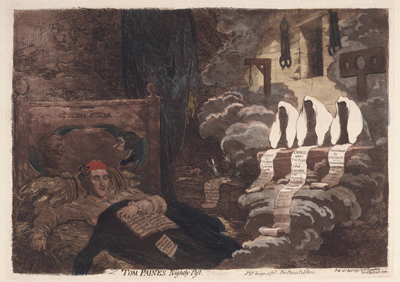Tom Paine's Nightly Pest (1)
This is the first of two versions of this print published approximately two weeks apart. The second was published on December 10th, 1792. Sometimes Gillray created a second version of a print to add or change details that reflect new information unavailable at the time of the first printing or alternatively to reach a slightly different audience. In this case, it is likely that he was simply disappointed with the muddy appearance of the print, the lack of clarity caused by the use of aquatint to suggest the darkened room. The British Museum copy of this print, for instance, which appears to be uncolored, is even darker and less legible. But in the second version, largely copied from this version but without using aquatint, he did take the opportunity to add a number of details that improve the print.

© Lewis Walpole Library, Yale University
Paine is shown lying asleep on a bed of straw in a dark, shabby, and prison-like room. His nightcap, with revolutionary cockade, is emblazoned with the word LIBERTAS. On his coat which is being used as a blanket are two volumes lying open which help to identify the figure as Paine. The first is a parody of (and allusion to) Paine's The Rights of Man: "The Rights of Farthing Candles proving their Equality with the Sun & Moon And the Necessity of a Reformation in the Planetary System". The second alludes, once again ironically, to Paine's earlier pamphlet, Common Sense (1776) which was a catalyst for the American Declaration of Independence: "Common Sense or Reason destructive to Free Government." His tri-colored pillow is labeled, "Vive l'America."
The headboard of his bed shows his two English "Guardian Angels" the dissenting Minister and liberal theorist Joseph Priestley and the head of the Whigs and ardent supporter of the French, Charles James Fox. Gillray seems not to have been acquainted with or interested in Paine's appearance, for the figure of Paine is both generic and uncaricatured. It is not until Fashion Before Ease. . . (1793) that Gillray creates a genuine caricature of Paine's appearance. Next to the bed and suggestive of Paine's situation were he still living in England in the fall of 1792 is a rat with his head in a trap. A new parody manuscript is visible next to a pen and candle: "The Golden Age. The Age of Equalizing the Property of Princes and Pikemen.
The nightly pest of the title confronts him on the right: a nightmarish vision of trial and punishment, including three faceless judges before whom are listed Paine's pleas, charges, and punishments, with a gallows, chains, barred window, and stocks behind. The pleas include "Ignorance, Poverty, and Envy"; the charges, "Libels, Scurrilities, Lies, Perjuries, Rebellions, and Treasons"; and the punishments, "Corporal Pain, Contempt, and Detestation." Casting the entire scene as a dream allows Gillray to include what are, in effect, a series of emblematic symbols in a dramatically justified manner.
One can understand why Gillray would have first turned to aquatint to suggest the darkness of the vision. England had just embarked on a period of curtailing the traditional freedom of the press in England, and Gillray must have known that he too could someday be prosecuted for his opinions.
Sources and Reading
- Commentary from the British Museum on Tom Paine's Nightly Pest
- "Thomas Paine," Wikipedia
Comments & Corrections
NOTE: Comments and/or corrections are always appreciated. To make that easier, I have included a form below that you can use. I promise never to share any of the info provided without your express permission.